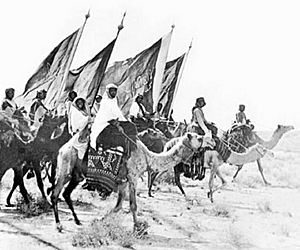Ikhwan raids on Transjordan facts for kids
Quick facts for kids Ikhwan raids on Transjordan |
|||||||||
|---|---|---|---|---|---|---|---|---|---|
| Part of the Unification of Saudi Arabia | |||||||||
|
|||||||||
| Belligerents | |||||||||
|
|
Support: |
||||||||
| Commanders and leaders | |||||||||
|
|
|||||||||
| Strength | |||||||||
| 1,500 raiders (1922) 3,000–4,000 or 4,500 camel raiders |
Unknown | ||||||||
| Casualties and losses | |||||||||
| 500+ killed (1924) | 130 tribesmen killed or wounded (1924) | ||||||||
|
Population of two small villages massacred |
|||||||||
The Ikhwan raids on Transjordan were a series of attacks by the Ikhwan, a group of Arab tribesmen from Najd, on Transjordan between 1922 and 1924. These repeated attacks from Najd were a big challenge for Emir Abdullah, who ruled Transjordan. The Emir could not stop these raids by himself. So, the British helped a lot, with their air force based near Amman. The British military force was the main reason the Ikhwan could not take over, helping Emir Abdullah keep control of Transjordan.
Contents
Why Did the Raids Happen?
After some conflicts, the British wanted to make sure Transjordan and Iraq were safe kingdoms for the Hashemite family. They worked hard to protect these areas from threats both inside and outside. The British military helped Emir Abdullah of Transjordan stop local uprisings in 1921 and 1923. They were also very important in stopping big attacks from the Wahhabi tribesmen of Najd, known as the Ikhwan.
While Transjordan was peaceful inside during 1922–1923, a new threat came from the southeast. The Ikhwan were a powerful group, used by King Ibn Saud to expand his lands. They moved north and west, reaching the borders of Transjordan in the summer of 1922. The Ikhwan were a strong fighting force made up of different tribes. Their strong religious beliefs and the King's support made them very tough opponents. This threat made the different nomadic tribes within Transjordan and the Transjordanian government work together for the first time.
First Major Attack
The Ikhwan started their first attack on Transjordan by raiding two villages. These villages were about 19 kilometers south of Amman and belonged to the Bani Sakhr tribe. In a two-day battle, the Hadid tribe and the remaining Bani Sakhr fighters joined forces. They managed to defeat the attackers. British armored cars and planes arrived to stop the raiders only after they had started to leave.
Second Major Attack
In August 1924, a much larger Ikhwan force attacked again. About 4,500 raiders traveled 1,600 kilometers from Najd (which is in modern-day Saudi Arabia). They came to attack Transjordan, which was protected by the British.
About 15 kilometers south of Amman, the raiders once again fought with the villages of Bani Sakhr. This time, the British Royal Air Force (RAF) attacked them. The Ikhwan army suffered many losses, with about 500 fighters killed. The villages that were attacked lost about 130 people.
What Happened Next?
Other Ikhwan raids happened later, during the 1927–1930 Ikhwan Revolt. These were against the authority of Ibn Saud himself. The Ikhwan raided southern Iraq in November 1927 and Kuwait in January 1928. In these raids, they stole camels and sheep. Even though they attacked fiercely, they faced strong counterattacks from the RAF and the Kuwaitis.
Eventually, Ibn Saud's regular army defeated the Ikhwan. Their leaders were killed, and the remaining fighters were made part of the regular Saudi army.
See also
- Sultan bin Najad
- Kuwait-Najd Border War
- Saudi Arabian National Guard
- List of modern conflicts in the Middle East


